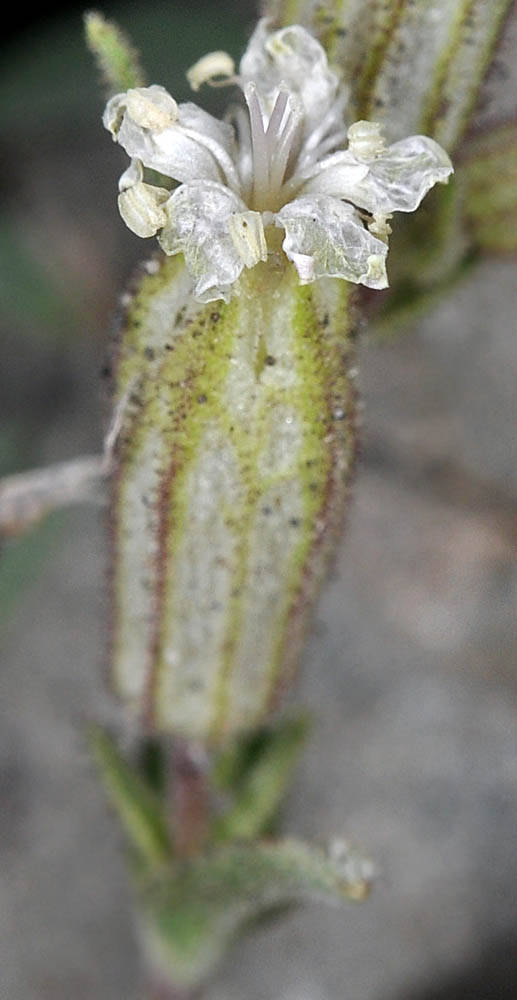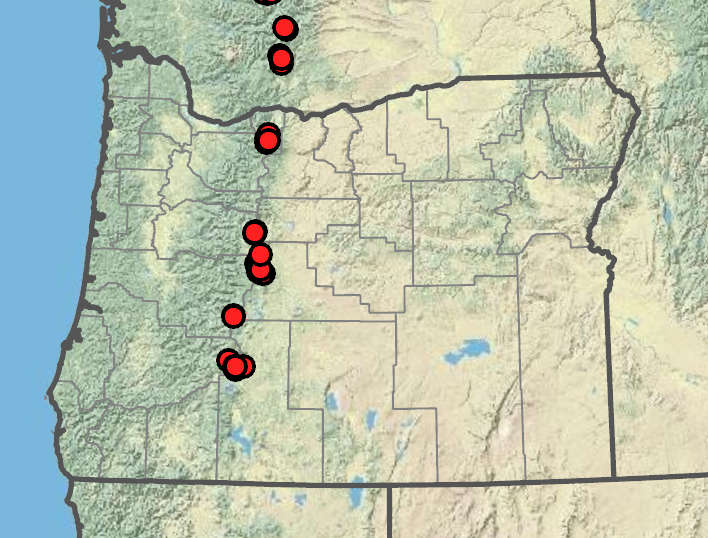Silene suksdorfii
Silene douglasii
Suksdorf's catchfly
Douglas' catchfly
decumbent to erect, 3–15 cm;
branches many, puberulent, glandular-viscid above.
decumbent to erect, 10–40(70) cm;
branches few to many; grayish white retrorsely puberulent, rarely glandular above.
basal narrowly oblanceolate, 0.5–4.5 cm × 1.5–3.5 mm, densely tufted; fleshy;
cauline in 1–3 pairs, linear-lanceolate, 0.5–1.5 cm × 1–2 mm, abruptly reduced upward.
basal oblanceolate or elliptic, 2–10 cm × 1.5–13 mm;
cauline ± linear, 1–4 cm × 1–5 mm, gradually reduced upward.
terminal; open cymes, not 1-sided, or flowers solitary;
pedicels glandular-viscid.
terminal or axillary; open cymes, not 1-sided;
pedicels grayish white retrorsely puberulent, rarely glandular above.
bisexual; erect;
calyces campanulate, not inflated in fruit, 9–12 mm; short-glandular-hairy, prominently 10-veined, not netted above; pale commissures present; commissural veins fork above and fuse with lobe veins, becoming papery;
cell walls of hairs purple;
lobes 1–2 mm;
tips acute to obtuse;
petal claws ciliate at base; appendages 2;
limbs 3–5 mm, white to purplish;
lobes 2;
stamens equaling petal claws;
styles 3(4), equaling petal claws.
bisexual, ascending to erect;
calyces campanulate, strongly (or not) inflated in fruit, 9–15(20) mm; grayish white retrorsely puberulent, rarely glandular, prominently 10-veined, not netted above; pale commissures present; commissural veins fork above and fuse with lobe veins;
lobes 2–3 mm;
tips blunt;
petal claws ciliate at base; appendages 2;
limbs 3–4(13) mm, white to pink or purplish;
lobes 2, 1–2 mm, sometimes with two lateral teeth;
stamens equaling petal claws;
styles 3–5, not to slightly exserted.
ovoid;
teeth 6(8);
stalks 2–3.5 mm.
oblong to ovoid;
teeth 3–5;
stalks 3–4 mm.
1–2 mm, brown, winged.
1–2 mm, brown, not winged.
=48.
Silene suksdorfii
Silene douglasii
Rocky crevices, ridges, slopes. Flowering Jul–Sep. 1600–2800 m. Casc, ECas. CA, WA. Native.
3 varieties. While the grayish white retrorse pubescence is usually diagnostic, some plants may be difficult to distinguish from S. parryi.
Rich Rabeler, Ronald Hartman
Rich Rabeler, Ronald Hartman
- Local floras:
CA,
OR,
WA
- Local Web sites:
CalFlora,
CalPhotos,
Flora NW,
PNW Herbaria
WildflowerSearch
iNaturalist (observations)
USDA Plants Database
- LBJ Wildflower Center
- SEINet
- Plants of the World Online
- Encyclopedia of Life
- Wikipedia
- Google Image Search





